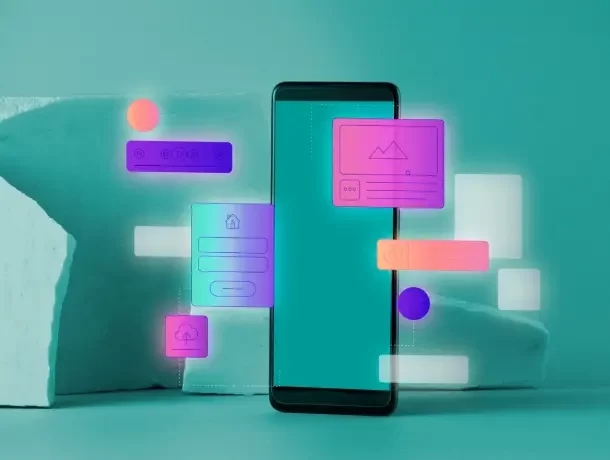
- June 24, 2024
- UI/UX design
Table of Contents
The role of UI/UX design is significant more than ever in the digital age when user experience is paramount. The field of user interface (UI) and user experience (UX) design is still developing as we march toward 2024, influencing how we utilize technology in our daily lives. The upcoming trends and challenges will shape the trajectory of UI/UX design in 2024, as well as the critical function that the design plays in the dynamic tech ecosystem.
Knowing UI/UX Design
It’s important to know the basics of UI/UX design before exploring its significance in 2024. While UX design is focused on increasing user happiness by making a product more accessible and usable, UI design is concerned with creating aesthetically pleasing interfaces that promote user interaction. consumer happiness through enhancing a product’s accessibility and usability. They work together to create the framework for seamless digital experiences available on various websites, apps, and gadgets.
The Transition to Tailored Experiences
By 2024, consumers expect experiences that are specifically catered to their interests and habits, placing a premium on personalization. The role of UI/UX designers is to use machine learning algorithms and data analytics to build dynamic interfaces that adjust to the demands of specific users. Customization, which promotes deeper engagement and brand loyalty, becomes the cornerstone of excellent UX design, ranging from flexible user interfaces to personalized recommendations.
Embracing Immersive Technologies

The role of the UI/UX design landscape will undergo a radical change due to the widespread use of immersive technologies like virtual reality (VR) and augmented reality (AR). The task for designers is to create immersive interfaces that blend The goal for designers is to create immersive interfaces that provide consumers with never-before-seen levels of engagement and involvement by fusing the physical and digital worlds together. The possibilities of UI/UX design are redefined by AR and VR, opening up new channels for creativity and innovation in anything from virtual shopping experiences to immersive product demos.
It is imperative that UI/UX designers comprehend the distinct context of immersive technologies and the ways in which users engage with them. This entails taking into account elements like hand gestures, gaze-based interactions, spatial navigation, and 3D space utilisation.
The goal of immersive experiences is to make people feel completely present and submerged in the virtual world. When it comes to creating interfaces and experiences that improve presence—like realistic settings, organic interactions, and engrossing audiovisual feedback—UI/UX designers are indispensable.
Traditional 2D interfaces are swapped out with spatial UI elements that are part of the 3D environment in VR and AR experiences. Intuitive and ergonomic spatial interfaces that are simple to use and maintain the immersive experience are what UI/UX designers need to create.
Smooth Multichannel Experiences

The role of UI/UX design now covers a wide range of devices and touchpoints in an era of omnichannel connection, going beyond traditional platforms. In order to ensure consistency in design components and user flows across many platforms, UI/UX designers need to take a comprehensive approach. By optimizing user experience across several platforms, designers enhance brand identity and promote unified user experiences.
As technology permeates more aspects of daily life, UI/UX design must prioritize ethical issues. Upholding privacy, inclusivity, and accessibility standards is the responsibility of designers in order to guarantee fair digital experiences for all users. As a fundamental principle of UI/UX design in 2024, ethical design standards force designers to give transparency, consent, and user empowerment top priority during the creative process. By advocating for ethical design, designers build credibility and trust with consumers, resulting in the development of lasting connections.
The Emergence of Conversational Interfaces
By utilizing artificial intelligence (AI) and natural language processing (NLP), conversational interfaces will completely transform how people engage with technology by 2024. Conversational user interfaces (UIs) are seamless, user-friendly interfaces that imitate human communication. They range from voice-activated interfaces to chatbots and virtual assistants. Play by UI/UX designers encounters that imitate spoken language. When it comes to creating conversational interfaces that read user intent, comprehend context, and provide tailored responses, UI/UX designers are essential. Designers close the gap between users and technology by humanizing interactions through conversational design, which raises user satisfaction and engagement levels.
Role of UI/UX design
In order to build digital interfaces that provide a positive user experience, one must grasp both the theoretical and practical components of UI/UX design.
- User Research: In order to comprehend the requirements, objectives, and preferences of the target audience, UI/UX designers begin by performing user research. Surveys, interviews, usability testing, and user behavior analysis may all be part of this.
- Information Architecture: To make a digital product easy to use and comprehend, designers arrange and structure its functions and information. This entails mapping out the arrangement and structure of information using wireframes, sitemaps, and user flows.
- Interaction Design: Interaction design focuses on how users interact with the interface and the actions they take to accomplish tasks. Clear navigation menus, buttons, forms, and interactive elements are designed by designers to create interfaces that are responsive and intuitive.
- Visual Design: Using fonts, colour schemes, images, and iconography, visual designers create the interface’s appealing appearance and feel. Designers strive to provide aesthetically pleasing designs that simultaneously uphold the corporate identity and elicit the intended emotional reaction from consumers.
- Iteration and Prototyping: Using interactive interface prototypes made with prototyping tools, designers may evaluate usability and get input from users and stakeholders. They continuously hone and improve the interface by iterating on the design in response to feedback.
- Usability Testing: To find any usability problems or pain spots, usability testers watch actual users interact with the interface. To improve the user experience and create well-informed design decisions, designers employ the knowledge gathered from usability testing.
- Accessibility: By adhering to accessibility guidelines and best practices, UI/UX designers make sure that their designs are usable by people with impairments. This could entail creating content that is readable on screen readers, making sure that colours contrast well, and offering alternative text for photos.
- Collaboration and Communication: To make sure that the design is in line with the overall product vision and goals, UI/UX designers work closely with cross-functional teams made up of product managers, developers, and marketers. The ability to effectively communicate is necessary for presenting and defending design choices.
- Keeping Up with Trends and Technologies: To enhance their abilities and adjust to evolving user demands and preferences, UI/UX designers keep up with the most recent trends, technologies, and industry best practices.
Designers may produce digital goods and interfaces that are interesting, user-friendly, and successful in accomplishing their intended goals by grasping these UI/UX design elements.
Importance of UI/UX design
A key factor in the success of digital goods and services is UI/UX design.
- User Satisfaction: By offering user-friendly interfaces that are simple to use and navigate, well-designed UI/UX designs increase user satisfaction. Users are more likely to enjoy a product when they can locate what they need and complete tasks with ease.
- User Engagement: The role of UI/UX design has a captivating effect and may draw in users and encourage them to return for more. User interaction with a product is encouraged by well-designed interfaces, which boost engagement and cultivate loyalty.
- Brand Reputation: Professionalism, dependability, and trustworthiness are all communicated by a well-designed UI/UX, which reflects highly on the brand. A satisfying user experience can boost a brand’s reputation and set a product apart from rivals.
- A Higher Conversion Rate: Users are guided through the conversion funnel by intuitive UI/UX designs, which makes it simpler for them to finish desired actions like buying something, signing up for a service, or subscribing to a newsletter. Better business outcomes and increased conversion rates may result from this.
- Decreased Costs: Investing early in UI/UX design can help steer clear of later, expensive redesigns and iterations. Early in the development process, designers can better grasp consumer wants and preferences, leading to more effective solutions that require fewer changes.
- Accessibility: The role of UI/UX design takes into account the many requirements of users, including individuals with disabilities. By adhering to accessibility best practices, designers may make sure that the greatest number of individuals can use their products, increasing inclusivity and expanding their target market.
- Rivalry Competitive Advantage: A product can have an advantage over rivals in the congested market of today with a well-designed UI/UX. Businesses may stand out from the competition and draw in more business by offering a better user experience.
The role of UI/UX design is crucial to producing goods and services that satisfy consumer demands, encourage interaction, and support the growth of companies and brands.
Conclusion
The role of UI/UX design in 2024 will go beyond simple aesthetics to include a comprehensive strategy that puts ethics, personalization, and immersion first. With the speed at which technology is developing, UI/UX designers are driving innovation and creating the digital experiences of the future. Designers may successfully navigate the constantly evolving field of UI/UX design, improving user experiences and making a good influence in the digital sphere, by embracing emerging trends, updates and adhering to ethical principles.











